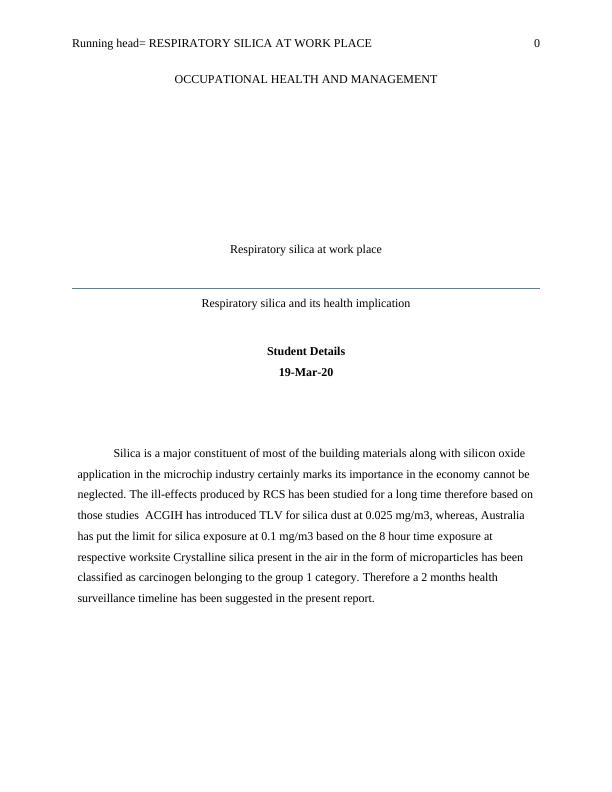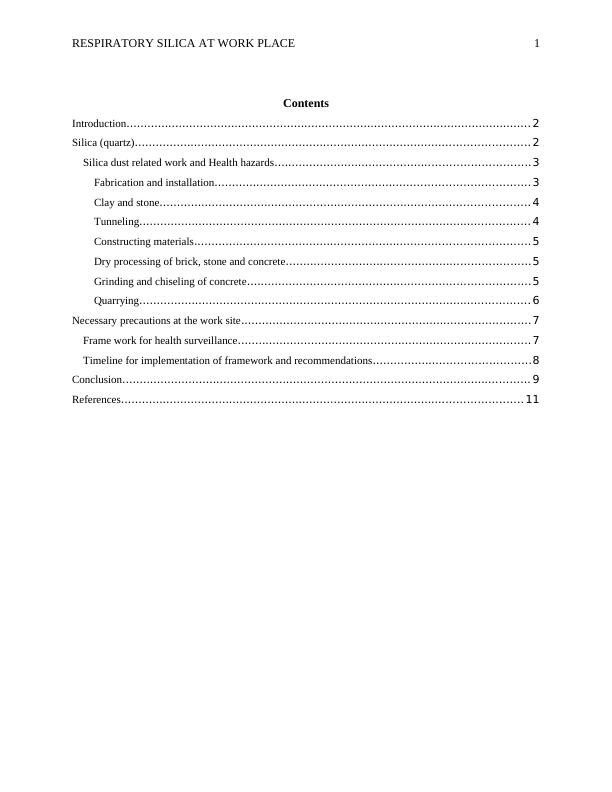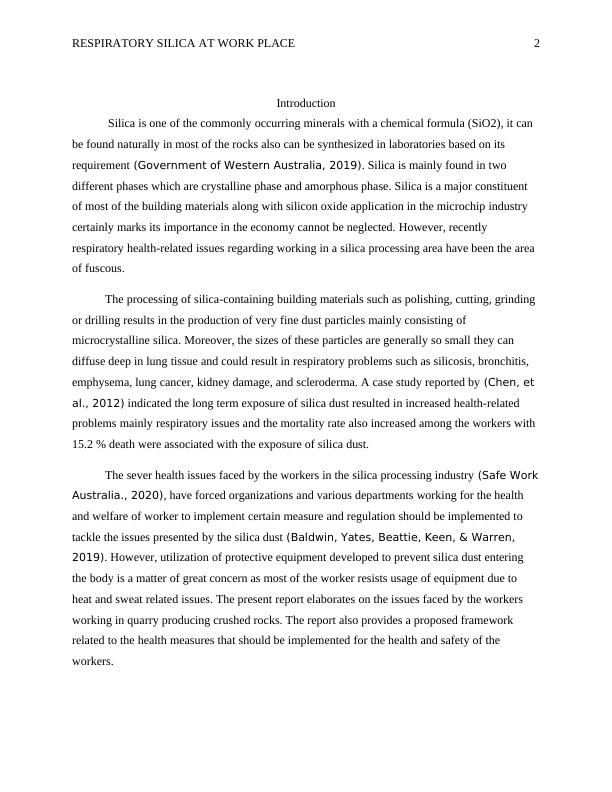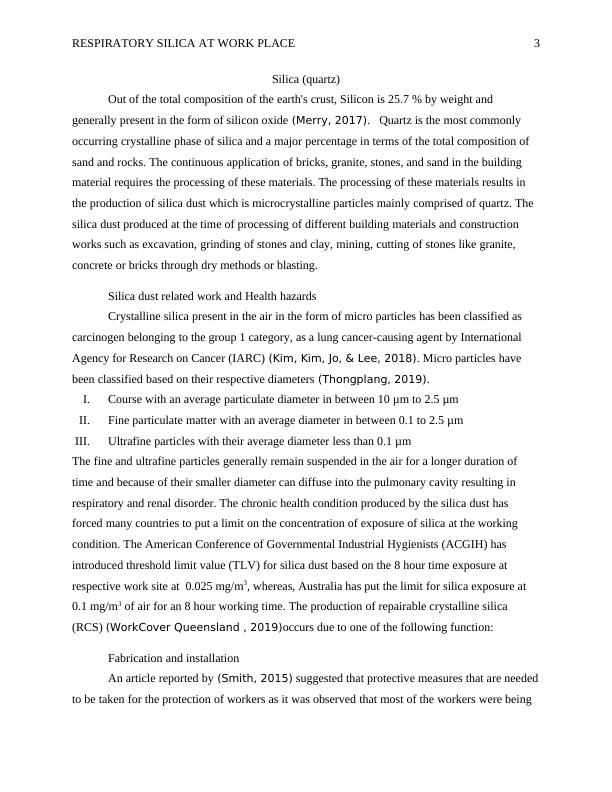Silica – Technical guide to managing exposure in the workplace
Added on 2022-08-17
15 Pages4912 Words17 Views
Running head= RESPIRATORY SILICA AT WORK PLACE 0
OCCUPATIONAL HEALTH AND MANAGEMENT
Respiratory silica at work place
Respiratory silica and its health implication
Student Details
19-Mar-20
Silica is a major constituent of most of the building materials along with silicon oxide
application in the microchip industry certainly marks its importance in the economy cannot be
neglected. The ill-effects produced by RCS has been studied for a long time therefore based on
those studies ACGIH has introduced TLV for silica dust at 0.025 mg/m3, whereas, Australia
has put the limit for silica exposure at 0.1 mg/m3 based on the 8 hour time exposure at
respective worksite Crystalline silica present in the air in the form of microparticles has been
classified as carcinogen belonging to the group 1 category. Therefore a 2 months health
surveillance timeline has been suggested in the present report.
OCCUPATIONAL HEALTH AND MANAGEMENT
Respiratory silica at work place
Respiratory silica and its health implication
Student Details
19-Mar-20
Silica is a major constituent of most of the building materials along with silicon oxide
application in the microchip industry certainly marks its importance in the economy cannot be
neglected. The ill-effects produced by RCS has been studied for a long time therefore based on
those studies ACGIH has introduced TLV for silica dust at 0.025 mg/m3, whereas, Australia
has put the limit for silica exposure at 0.1 mg/m3 based on the 8 hour time exposure at
respective worksite Crystalline silica present in the air in the form of microparticles has been
classified as carcinogen belonging to the group 1 category. Therefore a 2 months health
surveillance timeline has been suggested in the present report.

RESPIRATORY SILICA AT WORK PLACE 1
Contents
Introduction.................................................................................................................... 2
Silica (quartz)................................................................................................................. 2
Silica dust related work and Health hazards.........................................................................3
Fabrication and installation.......................................................................................... 3
Clay and stone.......................................................................................................... 4
Tunneling................................................................................................................ 4
Constructing materials................................................................................................ 5
Dry processing of brick, stone and concrete......................................................................5
Grinding and chiseling of concrete.................................................................................5
Quarrying................................................................................................................ 6
Necessary precautions at the work site...................................................................................7
Frame work for health surveillance.................................................................................... 7
Timeline for implementation of framework and recommendations.............................................8
Conclusion..................................................................................................................... 9
References................................................................................................................... 11
Contents
Introduction.................................................................................................................... 2
Silica (quartz)................................................................................................................. 2
Silica dust related work and Health hazards.........................................................................3
Fabrication and installation.......................................................................................... 3
Clay and stone.......................................................................................................... 4
Tunneling................................................................................................................ 4
Constructing materials................................................................................................ 5
Dry processing of brick, stone and concrete......................................................................5
Grinding and chiseling of concrete.................................................................................5
Quarrying................................................................................................................ 6
Necessary precautions at the work site...................................................................................7
Frame work for health surveillance.................................................................................... 7
Timeline for implementation of framework and recommendations.............................................8
Conclusion..................................................................................................................... 9
References................................................................................................................... 11

RESPIRATORY SILICA AT WORK PLACE 2
Introduction
Silica is one of the commonly occurring minerals with a chemical formula (SiO2), it can
be found naturally in most of the rocks also can be synthesized in laboratories based on its
requirement (Government of Western Australia, 2019). Silica is mainly found in two
different phases which are crystalline phase and amorphous phase. Silica is a major constituent
of most of the building materials along with silicon oxide application in the microchip industry
certainly marks its importance in the economy cannot be neglected. However, recently
respiratory health-related issues regarding working in a silica processing area have been the area
of fuscous.
The processing of silica-containing building materials such as polishing, cutting, grinding
or drilling results in the production of very fine dust particles mainly consisting of
microcrystalline silica. Moreover, the sizes of these particles are generally so small they can
diffuse deep in lung tissue and could result in respiratory problems such as silicosis, bronchitis,
emphysema, lung cancer, kidney damage, and scleroderma. A case study reported by (Chen, et
al., 2012) indicated the long term exposure of silica dust resulted in increased health-related
problems mainly respiratory issues and the mortality rate also increased among the workers with
15.2 % death were associated with the exposure of silica dust.
The sever health issues faced by the workers in the silica processing industry (Safe Work
Australia., 2020), have forced organizations and various departments working for the health
and welfare of worker to implement certain measure and regulation should be implemented to
tackle the issues presented by the silica dust (Baldwin, Yates, Beattie, Keen, & Warren,
2019). However, utilization of protective equipment developed to prevent silica dust entering
the body is a matter of great concern as most of the worker resists usage of equipment due to
heat and sweat related issues. The present report elaborates on the issues faced by the workers
working in quarry producing crushed rocks. The report also provides a proposed framework
related to the health measures that should be implemented for the health and safety of the
workers.
Introduction
Silica is one of the commonly occurring minerals with a chemical formula (SiO2), it can
be found naturally in most of the rocks also can be synthesized in laboratories based on its
requirement (Government of Western Australia, 2019). Silica is mainly found in two
different phases which are crystalline phase and amorphous phase. Silica is a major constituent
of most of the building materials along with silicon oxide application in the microchip industry
certainly marks its importance in the economy cannot be neglected. However, recently
respiratory health-related issues regarding working in a silica processing area have been the area
of fuscous.
The processing of silica-containing building materials such as polishing, cutting, grinding
or drilling results in the production of very fine dust particles mainly consisting of
microcrystalline silica. Moreover, the sizes of these particles are generally so small they can
diffuse deep in lung tissue and could result in respiratory problems such as silicosis, bronchitis,
emphysema, lung cancer, kidney damage, and scleroderma. A case study reported by (Chen, et
al., 2012) indicated the long term exposure of silica dust resulted in increased health-related
problems mainly respiratory issues and the mortality rate also increased among the workers with
15.2 % death were associated with the exposure of silica dust.
The sever health issues faced by the workers in the silica processing industry (Safe Work
Australia., 2020), have forced organizations and various departments working for the health
and welfare of worker to implement certain measure and regulation should be implemented to
tackle the issues presented by the silica dust (Baldwin, Yates, Beattie, Keen, & Warren,
2019). However, utilization of protective equipment developed to prevent silica dust entering
the body is a matter of great concern as most of the worker resists usage of equipment due to
heat and sweat related issues. The present report elaborates on the issues faced by the workers
working in quarry producing crushed rocks. The report also provides a proposed framework
related to the health measures that should be implemented for the health and safety of the
workers.

RESPIRATORY SILICA AT WORK PLACE 3
Silica (quartz)
Out of the total composition of the earth's crust, Silicon is 25.7 % by weight and
generally present in the form of silicon oxide (Merry, 2017). Quartz is the most commonly
occurring crystalline phase of silica and a major percentage in terms of the total composition of
sand and rocks. The continuous application of bricks, granite, stones, and sand in the building
material requires the processing of these materials. The processing of these materials results in
the production of silica dust which is microcrystalline particles mainly comprised of quartz. The
silica dust produced at the time of processing of different building materials and construction
works such as excavation, grinding of stones and clay, mining, cutting of stones like granite,
concrete or bricks through dry methods or blasting.
Silica dust related work and Health hazards
Crystalline silica present in the air in the form of micro particles has been classified as
carcinogen belonging to the group 1 category, as a lung cancer-causing agent by International
Agency for Research on Cancer (IARC) (Kim, Kim, Jo, & Lee, 2018). Micro particles have
been classified based on their respective diameters (Thongplang, 2019).
I. Course with an average particulate diameter in between 10 μm to 2.5 μm
II. Fine particulate matter with an average diameter in between 0.1 to 2.5 μm
III. Ultrafine particles with their average diameter less than 0.1 μm
The fine and ultrafine particles generally remain suspended in the air for a longer duration of
time and because of their smaller diameter can diffuse into the pulmonary cavity resulting in
respiratory and renal disorder. The chronic health condition produced by the silica dust has
forced many countries to put a limit on the concentration of exposure of silica at the working
condition. The American Conference of Governmental Industrial Hygienists (ACGIH) has
introduced threshold limit value (TLV) for silica dust based on the 8 hour time exposure at
respective work site at 0.025 mg/m3, whereas, Australia has put the limit for silica exposure at
0.1 mg/m3 of air for an 8 hour working time. The production of repairable crystalline silica
(RCS) (WorkCover Queensland , 2019)occurs due to one of the following function:
Fabrication and installation
An article reported by (Smith, 2015) suggested that protective measures that are needed
to be taken for the protection of workers as it was observed that most of the workers were being
Silica (quartz)
Out of the total composition of the earth's crust, Silicon is 25.7 % by weight and
generally present in the form of silicon oxide (Merry, 2017). Quartz is the most commonly
occurring crystalline phase of silica and a major percentage in terms of the total composition of
sand and rocks. The continuous application of bricks, granite, stones, and sand in the building
material requires the processing of these materials. The processing of these materials results in
the production of silica dust which is microcrystalline particles mainly comprised of quartz. The
silica dust produced at the time of processing of different building materials and construction
works such as excavation, grinding of stones and clay, mining, cutting of stones like granite,
concrete or bricks through dry methods or blasting.
Silica dust related work and Health hazards
Crystalline silica present in the air in the form of micro particles has been classified as
carcinogen belonging to the group 1 category, as a lung cancer-causing agent by International
Agency for Research on Cancer (IARC) (Kim, Kim, Jo, & Lee, 2018). Micro particles have
been classified based on their respective diameters (Thongplang, 2019).
I. Course with an average particulate diameter in between 10 μm to 2.5 μm
II. Fine particulate matter with an average diameter in between 0.1 to 2.5 μm
III. Ultrafine particles with their average diameter less than 0.1 μm
The fine and ultrafine particles generally remain suspended in the air for a longer duration of
time and because of their smaller diameter can diffuse into the pulmonary cavity resulting in
respiratory and renal disorder. The chronic health condition produced by the silica dust has
forced many countries to put a limit on the concentration of exposure of silica at the working
condition. The American Conference of Governmental Industrial Hygienists (ACGIH) has
introduced threshold limit value (TLV) for silica dust based on the 8 hour time exposure at
respective work site at 0.025 mg/m3, whereas, Australia has put the limit for silica exposure at
0.1 mg/m3 of air for an 8 hour working time. The production of repairable crystalline silica
(RCS) (WorkCover Queensland , 2019)occurs due to one of the following function:
Fabrication and installation
An article reported by (Smith, 2015) suggested that protective measures that are needed
to be taken for the protection of workers as it was observed that most of the workers were being

End of preview
Want to access all the pages? Upload your documents or become a member.
Related Documents
Risk of Lung Cancer in Foundry Workerslg...
|9
|2076
|76
Silica Dust Properties and Its Effects on Human Healthlg...
|6
|1547
|471
Assignment on Occupational Healthlg...
|18
|4045
|34
